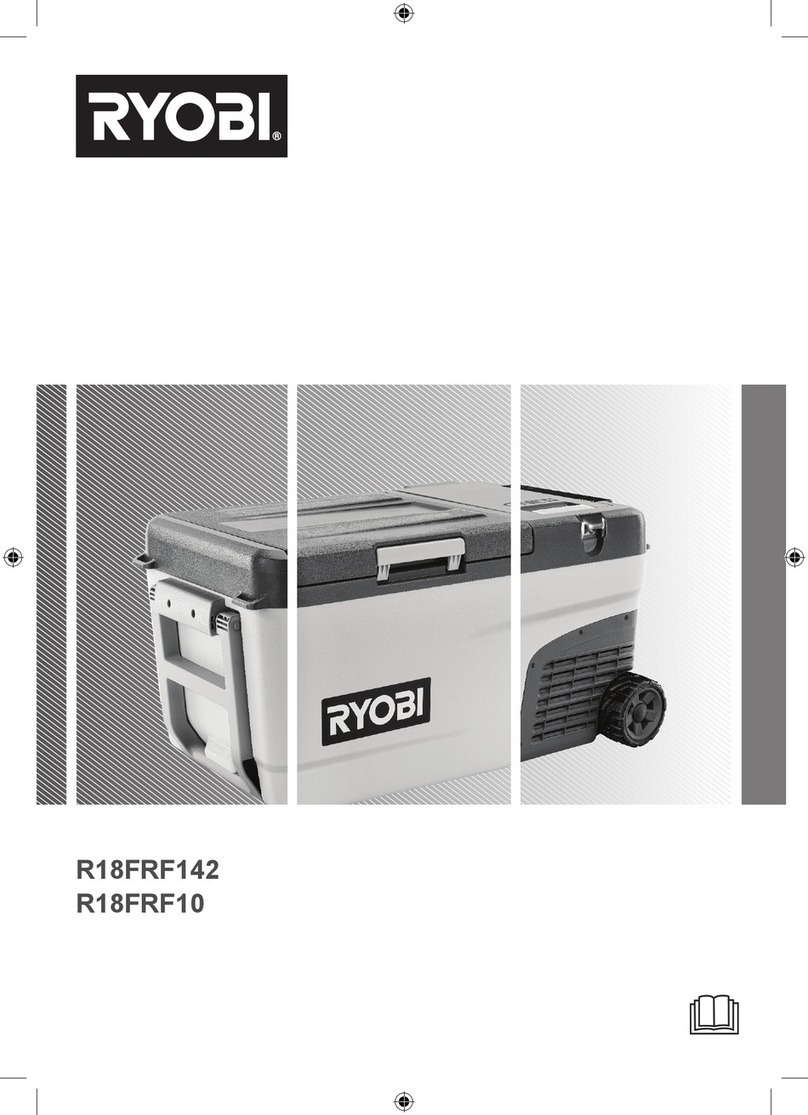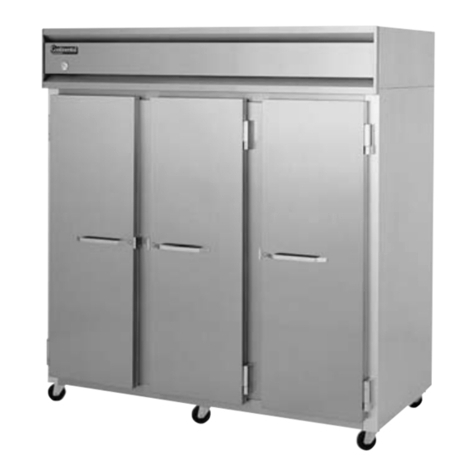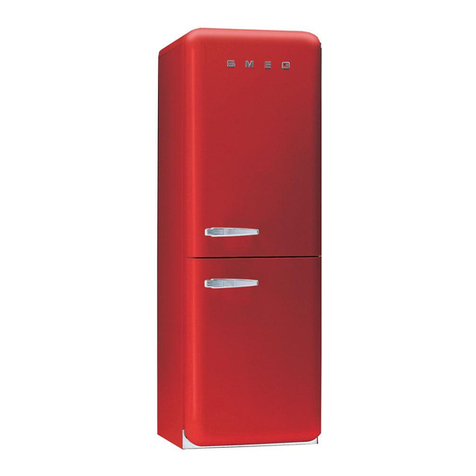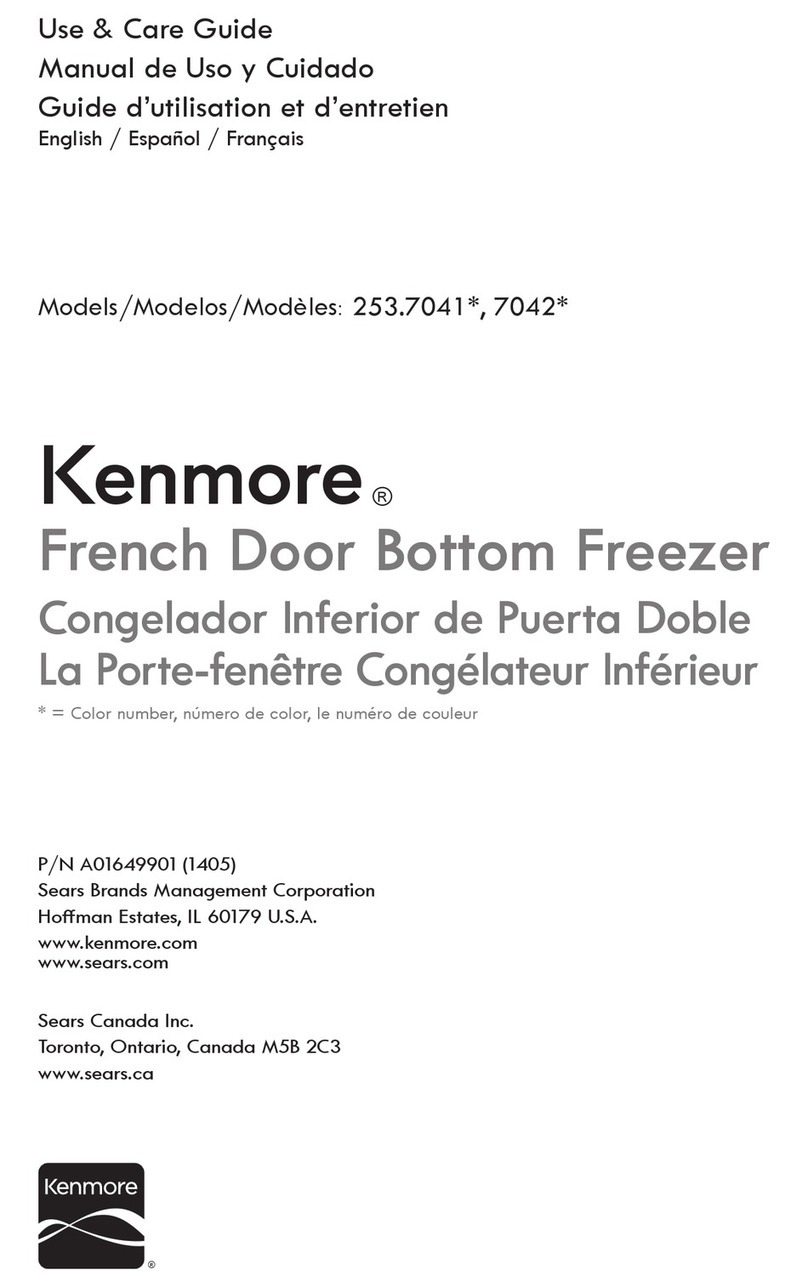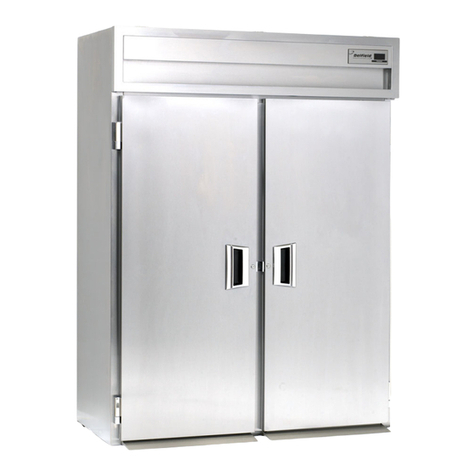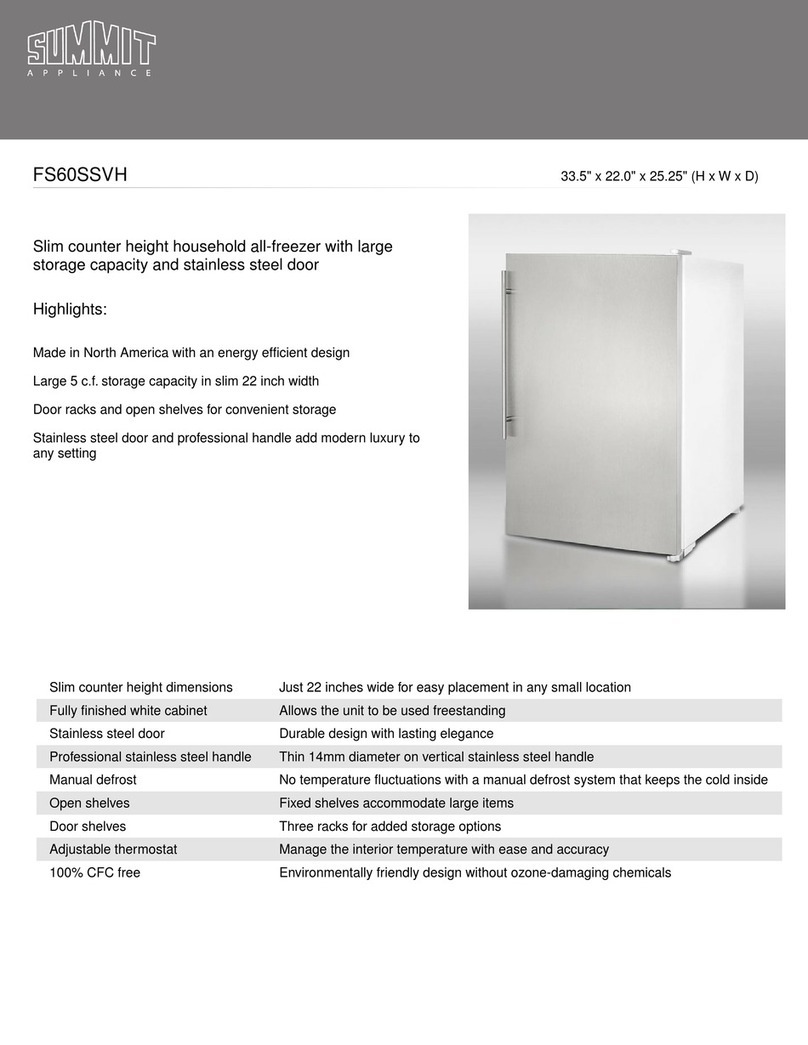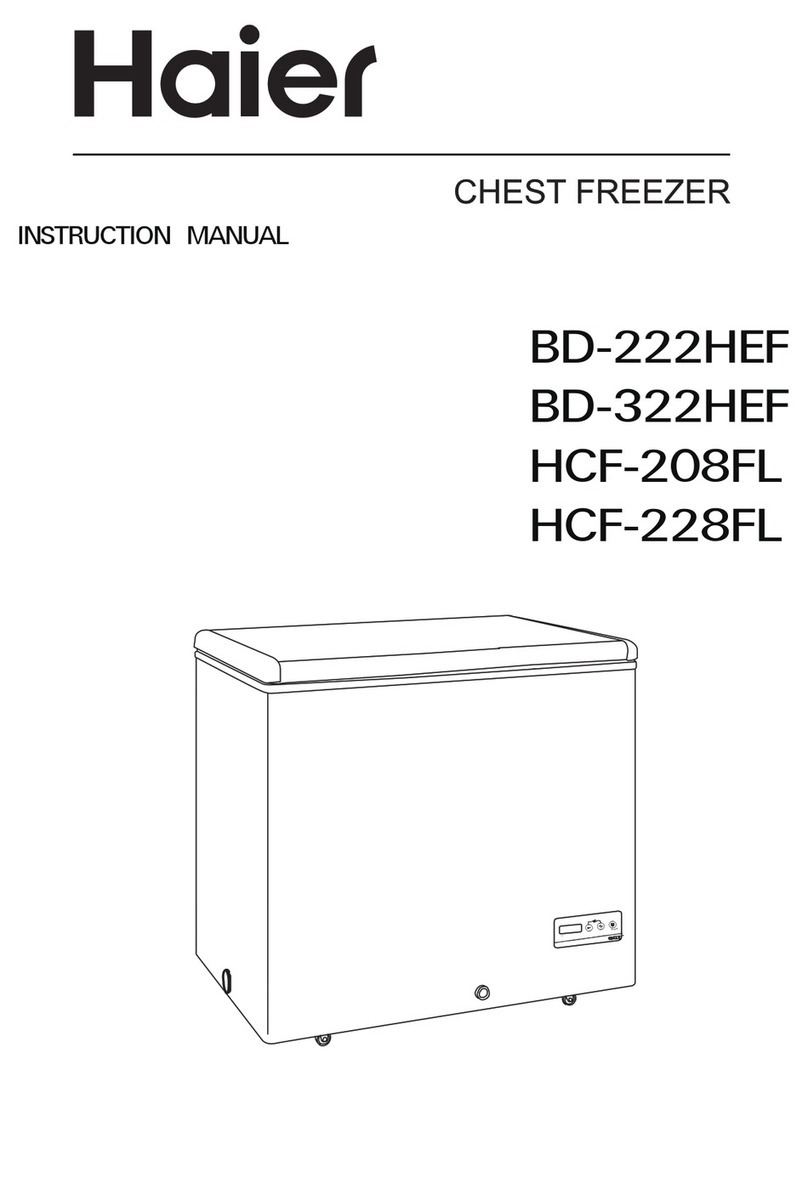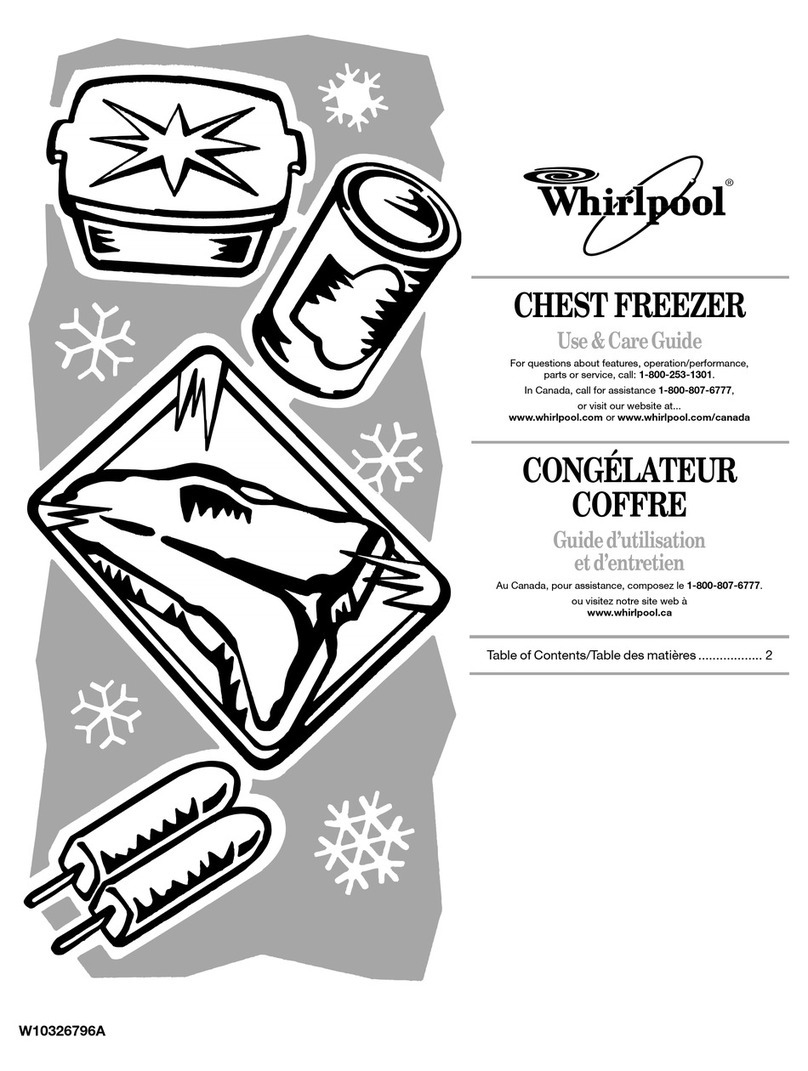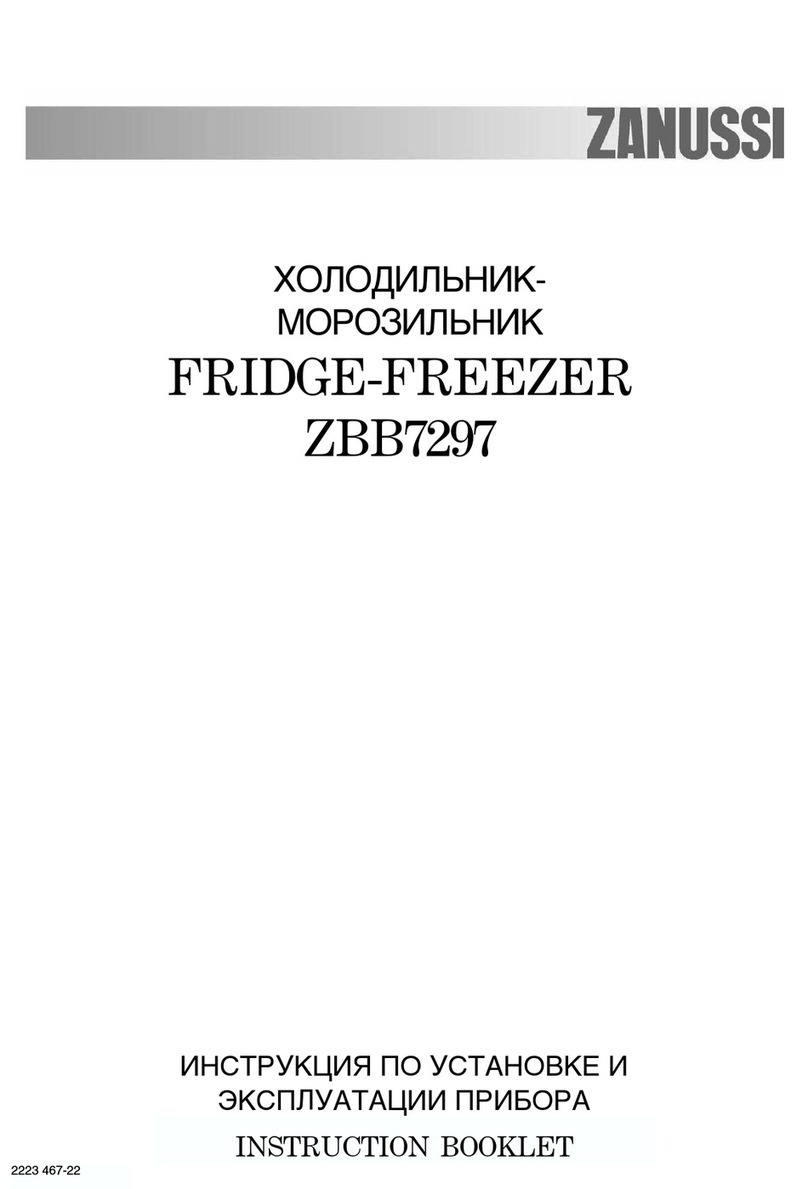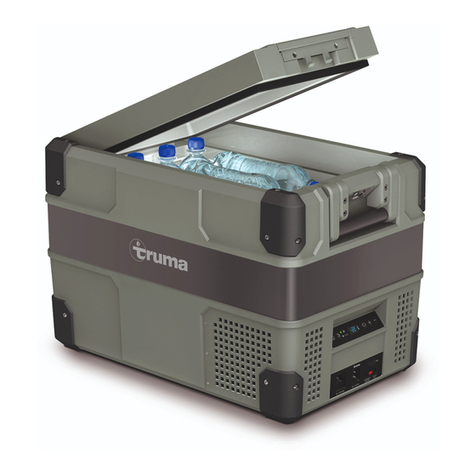GERATEK Halifax GT2400W User manual

Halifax GT2400W
Chest freezer (EN)
Gefriertruhe (DE)
Congélateur coffre (FR)
Frysbox (SE)
Vrieskist (NL)
Zamrażarka skrzyniowa (PL)
Морозильный ларь (RU)

- 1 -
Content –Inhalt –Teneur –Innehåll –Inhoud –Treść – Содержание
Instruction manual –English......................................................................................- 2 -
Bedienungsanleitung –German...............................................................................- 12 -
Mode d‘emploi – French..........................................................................................- 22 -
Bruksanvisning –Swedish ........................................................................................- 33 -
Gebruiksaanwijzing –Dutch.....................................................................................- 43 -
Instrukcja obsługi – Polish........................................................................................- 54 -
Инструкция по эксплуатации – Russian .................................................................- 65 -

- 2 -
Instruction manual –English
SAFETY INSTRUCTIONS
Before use make sure to read all of the below instructions in
order to avoid injury or damage, and to get the best results
from the appliance. Make sure to keep this manual in a safe
place. If you give or transfer this appliance to someone else
make sure to also include this manual.
In case of damage caused by user failing to follow the
instructions in this manual the warranty will be void. The
manufacturer/importer accepts no liability for damages
caused by failure to follow the manual, a negligent use or use
not in accordance with the requirements of this manual.
1. Read and save these instructions. Attention: pictures in
the instructions are for reference only.
2. This appliance can be used by children aged from 8 years
and above and persons with reduced physical, sensory or
mental capabilities or lack of experience and knowledge if
they have been given supervision or instruction
concerning use of the appliance in a safe way and
understand the hazards involved. Children shall not play
with the appliance. Cleaning and user maintenance shall
not be made by children without supervision.
3. Children aged from 3 to 8 years are allowed to load and
unload refrigerating appliances.
4. If the supply cord is damaged, it must be replaced by the
manufacturer, its service agent or similarly qualified
persons in order to avoid a hazard.
5. WARNING: Keep ventilation openings, in the appliance
enclosure or in the built-in structure, clear of obstruction.
6. WARNING: Do not use mechanical devices or other means
to accelerate the defrosting process, other than those
recommended by the manufacturer.
7. WARNING: Do not damage the refrigerant circuit.

- 3 -
8. WARNING: Do not use electrical appliances inside the food
storage compartments of the appliance, unless they are of
the type recommended by the manufacturer.
9. Do not store explosive substances such as aerosol cans
with a flammable propellant in this appliance.
10. This appliance is intended to be used in household and
similar applications such as
-staff kitchen areas in shops, offices and other working
environments;
-farm houses and by clients in hotels, motels and other
residential type environments;
-bed and breakfast type environments;
-catering and similar non-retail applications.
11. WARNING: When positioning the appliance, ensure the
supply cord is not trapped or damaged.
12. WARNING: Do not locate multiple portable socket-outlets
or portable power supplies at the rear of the appliance.
13. To avoid contamination of food, please respect the
following instructions:
-Opening the door for long periods can cause a significant
increase of the temperature in the
compartments of the appliance.
-Clean regularly surfaces that can come in contact with
food and accessible drainage systems.
-Clean water tanks if they have not been used for 48h;
flush the water system connected to a water supply if
water has not been drawn for 5 days. (Only applicable to
water dispenser and water inlet system.)
-Store raw meat and fish in suitable containers in the
refrigerator, so that it is not in contact with or drip onto
other food.
-Two-star frozen-food compartments are suitable for
storing pre-frozen food, storing or making ice cream and
making ice cubes.
-One-, two- and three-star compartments are not suitable
for the freezing of fresh food.

- 4 -
-If the refrigerating appliance is left empty for long
periods, switch off, defrost, clean, dry, and leave the
door open to prevent mould developing within the
appliance.
14. This appliance is not intended to be used as a built-in
appliance.
15. Climate class:
-Extended temperate (SN): 'this refrigerating appliance is
intended to be used at ambient temperatures ranging
from 10°C to 32 °C';
-Temperate(N): 'this refrigerating appliance is intended to
be used at ambient temperatures ranging from 16 °C to
32 °C';
-Subtropical (ST): 'this refrigerating appliance is intended
to be used at ambient temperatures ranging from 16 °C
to 38 °C';
-Tropical(T): 'this refrigerating appliance is intended to be
used at ambient temperatures ranging from 16 °C to
43 °C'.
16. Do not use it outdoors. Keep it away from sources of heat,
direct sunlight and humidity.
17. When not in use, for cleaning, user maintenance works or
with disruption, switch off the appliance and disconnect
the plug (pull the plug itself, not the lead) or turn off the
fuse.
18. Children should be supervised to ensure that they do not
play with the appliance.
19. It is recommended to check regularly the supply cord for
any sign of possible deterioration, and the appliance
should not be used if the cable is damaged.
20. Regarding the information pertaining to the installation,
handling, use, servicing, replacement of lamp (if applicable),
cleaning and disposal of the appliance, thanks to refer to
the below paragraph of the manual.

- 5 -
WARNING: Risk of fire / flammable materials
The coolant circuit of this unit contains the refrigerant
Isobutane (R600a), a natural gas that is flammable and of high
environmental compatibility. Make sure no parts of the
coolant circuit get damaged during transport and installation
of the appliance.
If the coolant circuit is damaged:
avoid any open flames or ignition source;
disconnect the plug;
thoroughly air the room in which the appliance is installed
and contact an authorized technician.

- 6 -
Halifax GT2400W EN
TRANSPORT AND PACKAGING
Transport the appliance
Transport the appliance, if possible, in vertical position. Otherwise, it is absolutely necessary to allow the
appliance standing upright for four hours before installation ”Prior to first use”. Protect the appliance during
transport against weather influences.
NOTE: The appliance has wheels which facilitate the transport and installation of the appliance.
Unpacking the appliance
Remove the appliance from its packaging.
To prevent hazards, check the appliance for any transport damage.
NOTE: Production residue or dust may have collected on the appliance. We recommend cleaning the appliance
according to chapter “Cleaning and Maintenance”.
APPLIANCE EQUIPMENT
Appliance overview
1. Integrated lid handles
2. Freezing basket
3. Water discharge opening
4. Temperature control
5. Control lamp
6. Ice scraper
INSTALLATION
Conditions for the installation location
Good ventilation is required around the appliance to dissipate the heat properly and to guarantee efficient
cooling operation at low power consumption. Enough clearance is necessary.
-Gap to the back approx. 50-70 mm, to the side walls each approx. 100 mm;
-Place the appliance so that the appliance lid can open without being impeded.
Only install at a location with an ambient temperature suitable for the climate class of the appliance. The
climate class can be found under "TECHNICAL SPECIFICATIONS".
Place the appliance on a steady and safe surface. If the appliance is not horizontally leveled, adjust the
feet accordingly.

- 7 -
Avoid the installation:
-near heaters, next to a stove, direct sunlight or any other heat sources;
-at locations with high humidity (e.g. outdoors, bathroom), as metal parts would be susceptible to
corrosion under such circumstances;
-near volatile or flammable materials (e.g. gas, fuel, alcohol, paint, etc.), in rooms which may have poor
air circulation (e.g. garages).
-Do not expose the appliance to any weather.
Electrical connection
Warning:
The installation to the mains supply must conform to the local standards and regulations.
Improper connection may cause to an electric shock!
Do not modify the appliance plug. If the plug does not fit properly to the outlet, let install a proper outlet
by an authorized specialist.
The accessibility of the power plug must be ensured to disconnect the appliance from the power supply in
case of emergency.
Make sure that the voltage supply matches the specifications on the rating label before connecting.
Connect the mains cable to a properly installed and earthed wall outlet.
If the plug after installation is not accessible, a corresponding disconnect device must be available to meet
the relevant safety regulations.
STARTUP / OPERATION
Prior to first use
Caution:
After transport, the appliance should be left standing upright for four hours before connecting to the power
supply. Nonobservance could lead to malfunction of the cooling system and causes an appliance break-down.
Clean the appliance interior including all accessory parts. Consider the instructions which we provide in the
chapter “Cleaning and Maintenance”.
Starting the appliance
Connect the appliance to the power supply; the control lamp illuminates.
Operate the temperature control with the help of the included plastic plate. See also the section "Settings".
Settings
As soon as the appliance is connected to the power supply, the control lamp lights up.
Setting [ 0 ] means that the appliance is in the off state. Turn the temperature control clockwise, starting from
this setting; the appliance will turn on automatically.
The power levels [ 1 –7 ] regulate the different values of the internal temperature.
Power level 1: Temperature range approx. -8°C ∼-12°C
Power level 2 - 3: Temperature range approx. -12°C ∼-15°C
Power level 4: Temperature range approx. -15°C ∼-18°C
Power level 5 - 6: Temperature range approx. -18°C ∼-20°C
Power level 7: Temperature range approx. -20°C ∼-25°C
Beware, the compressor won’t stop and works all the time.
Basically, the temperature will change depending on the ambient temperature, frequency of lid opening and the
amount of food in the appliance.

- 8 -
During initial operation, turn the temperature control to the highest setting first, until the appliance has
reached the desired operating temperature. Afterwards it is recommended to turn the control back to a
medium setting; correcting the temperature at a later point would then be easier.
Note:
In generally a medium power level works best for an optimized food storage. A high power level also increases
the energy consumption.
Storing food
Note: Recommendation!
To guarantee that the temperature is low enough, you should pre-cool the appliance a few times before initial
loading foods.
Caution: Always pay attention to the storage instructions on the sales packaging.
The 4-star freezer allows you to store frozen food at a temperature of ≤ -18°C for several months; to produce
ice cubes and to freeze fresh food.
To avoid contamination of food, respect the following instructions:
Opening the lid for long periods can cause a significant increase of the temperature in the compartments
of the appliance.
Clean regularly surfaces that can come in contact with food and accessible drainage systems (see
“Cleaning and Maintenance”).
Store raw meat and fish in suitable containers in the appliance, so that it is not in contact with or drip
onto other food.
If the appliance is out of use for long period, follow the instructions under "Switching off".
Storage space
If necessary, the freezing basket can be removed to optimize the storage space.
Freezing
Fresh food should be frozen as fast as possible to the core. During freezing operation, the temperature
of fresh food should be lowered as fast as possible to keep formation of ice crystals as little as possible
and not to damage the food structure.
If possible, keep a space between the individual items, so that the cold air can circulate.
The following foods are suitable for freezing: Cakes and pastries, fish and seafood, meat, game, poultry,
vegetables, fruit, herbs, eggs without shells, dairy products such as cheese and butter, ready meals and
leftovers such as soups, stews, cooked meat and fish, potato dishes, soufflés and desserts.
The following foods are not suitable for freezing: Types of vegetables, which are usually consumed raw,
such as lettuce or radishes, eggs in shells, grapes, whole apples, pears and peaches, hard-boiled eggs,
yoghurt, soured milk, sour cream, and mayonnaise.
Storing frozen food
Packed frozen merchandise should be stored in a 4-star-freezer compartment in accordance with the
manufacturer’s data. Make sure the food items do not defrost after purchase and to store them as fast
as possible in the freezer.
It is possible to store food for longer periods of time, up to three months. This period might vary, so
observe the storage information on the packaging of the merchandise.
Make sure that the temperature in the freezer does not rise above -18°C. For this, the unit should be
defrosted regularly. A thick frozen layer deteriorates the cooling and increases the power consumption.

- 9 -
General safety precautions
Do not store bottles or cans. These can break when the contents freeze –or even explode if they contain
carbonated drinks.
Once products have been defrosted halfway or completely, they should be consumed as soon as possible
and should not be frozen again, except they have been processed to a ready meal.
Do not eat food that is still frozen. Do not eat ice cream directly from the freezer. The cold can cause
injuries in the oral cavity.
Touching metal parts inside the unit can cause symptoms like burns if the skin is very sensitive.
Never touch frozen food with moist or wet hands.
Operating noise
Type of sound
Cause
Mumbling
Compressor during its operation
Liquid sounds
Circulation of the refrigerant
Click sounds
The temperature control turns the
compressor on or off
Disturbing noises
Vibration of the shelves or cooling coils
Switching off
To switch off the appliance turn the temperature control to the off state.
If the appliance is out of use for long periods:
Remove the appliance content.
Disconnect the appliance from the power supply.
Defrost and clean the device thoroughly (see ”Cleaning and Maintenance”).
Leave open the appliance lid to avoid formation of mold and unpleased odor.
Tips for energy saving
Disconnect the appliance from the power supply if it isn’t in use.
Do not install the appliance near stoves, heaters or other heat sources. In case of higher ambient
temperatures, the compressor will run more frequently and longer.
Ensure enough ventilation at the bottom and rear side. Never block ventilation openings.
Adjust the temperature not colder than necessary.
Allow warm food to cool before placing it in the appliance.
Open the unit lid only as necessary.
Defrost the unit regularly.
The seal of the appliance lid must be completely intact, so that the door closes properly.
CLEANING AND MAINTENANCE
Warning:
Always disconnect the appliance from the power supply before cleaning and user maintenance.
Do not use steam cleaners for cleaning the appliance; moisture could enter electrical components.
Risk of electric shock! Hot steam could damage the plastic parts.
The unit must be dry before restarting operation.
Caution:
Do not use a wire brush or other sharp, abrasive items.
Do not use any acidic or abrasive detergents.
Do not damage the refrigerant circuit.

- 10 -
Cleaning the appliance including interior
Clean the appliance interior, the exterior surfaces, the accessories and the lid seal regularly with warm
water and mild detergent; or with a clean, damp microfiber cloth without cleaning agent.
Remove the appliance content and store it at a cool location.
After everything was thoroughly dried, you can restart the operation.
Defrosting
Caution:
Never use metal objects (e.g. knifes) to remove ice from the evaporator. Otherwise, it can be damaged.
Note:
To speed up the defrosting process, make use of the included ice scraper.
To achieve better cooling and to save energy, defrost the appliance regularly as follows:
To start the defrosting process, disconnect the appliance from the power supply.
Remove the appliance content and keep covered at a cool location.
Open the water discharge channel at the appliance bottom and the water discharge opening at the
appliance front. Place a drip tray under to catch leaking water.
When the ice has melted, wipe the condensate away and dry the appliance interior.
Then you may restart the appliance by connecting the plug and turning the temperature control.
TROUBLESHOOTING
Before you contact an authorized specialist
Problem
Cause / Action
Unit is not working properly or at
all
Check the power supply / temperature
setting / ambient temperature.
Unblock the ventilation openings, install
the unit freely.
Loading is too warm
Check the temperature setting / ambient
temperature.
Open the lid only as long as necessary.
Loud noise during operation
Check the appliance position.
See the section “Operating noise”.
Water on the unit bottom
Check the temperature setting / water
discharge channel or opening.
Note: If a problem persists after following the steps above, contact your trader or an authorized technician.
TECHNICAL SPECIFICATIONS
Rated voltage:
220-240V~
Rated current:
1.5A
Rated frequency:
50Hz
Climate class:
N/ST
Refrigerant:
R600a (61g)
Protection against electrical shock:
I
Insulation blowing gas:
CYCLOPENTANE

- 11 -
Climate class:
-Extended temperate (SN): 'this refrigerating appliance is intended to be used at ambient temperatures
ranging from 10°C to 32 °C';
-Temperate(N): 'this refrigerating appliance is intended to be used at ambient temperatures ranging from
16 °C to 32 °C';
-Subtropical (ST): 'this refrigerating appliance is intended to be used at ambient temperatures ranging from
16 °C to 38 °C';
-Tropical(T): 'this refrigerating appliance is intended to be used at ambient temperatures ranging from 16 °C
to 43 °C';
Note: More data information, please scan the QR code on the energy label.
GUARANTEE AND CUSTOMER SERVICE
Before delivery our devices are subjected to rigorous quality control. If, despite all care, damage has occurred
during production or transportation, please return the device to your dealer. In addition to statutory legal rights,
the purchaser has an option to claim under the terms of the following guarantee:
For the purchased device we provide 2 years guarantee, commencing from the day of sale. If you have a
defective product, you can directly go back to the point of purchase.
Defects which arise due to improper handling of the device and malfunctions due to interventions and repairs
by third parties or the fitting of non-original parts are not covered by this guarantee. Always keep your receipt,
without the receipt you can’t claim any form of warranty. Damage caused by not following the instruction
manual, will lead to a void of warranty, if this results in consequential damages then we will not be liable. Neither
can we hold responsible for material damage or personal injury caused by improper use or if the instruction
manual are not properly executed. Damage to accessories does not mean free replacement of the whole
appliance. In such case please contact our service department. Broken glass or breakage of plastic parts is always
subject to a charge. Defects to consumables or parts subjected to wearing, as well as cleaning, maintenance or
the replacement of said parts are not covered by the warranty and are to be paid.
The guarantee period of the spare parts is 2 years. If you need replacement, please contact our customer service.
ENVIRONMENT FRIENDLY DISPOSAL
Recycling –European Directive 2012/19/EU
This marking indicates that this product should not be disposed with other household wastes. To
prevent possible harm to the environment or human health from uncontrolled waste disposal,
recycle it responsibly to promote the sustainable reuse of material resources. To return your used
device, please use the return and collection systems or contact the retailer where the product was purchased.
They can take this product for environmental safe recycling.
For professional repair and ordering spare parts, please contact our customer service.
Emerio B.V.
Zomervaart 1A
2033 DA Haarlem
The Netherlands
Customer service:
T: +31(0)23 3034369
E: info.nl@emerio.eu

- 12 -
Bedienungsanleitung –German
SICHERHEITSINFORMATIONEN
Lesen Sie vor dem Gebrauch unbedingt die nachfolgenden
Anleitungen, um Verletzungen oder Beschädigungen zu
vermeiden und das beste Ergebnis mit dem Gerät zu erzielen.
Bewahren Sie diese Bedienungsanleitung an einem sicheren
Ort auf. Wenn Sie dieses Gerät an eine andere Person
weitergeben, stellen Sie sicher, dass Sie auch diese
Bedienungsanleitung aushändigen.
Im Falle von Beschädigungen, die durch die Missachtung der
Anleitungen in dieser Bedienungsanleitung verursacht
wurden, wird die Garantie ungültig. Der Hersteller/Importeur
haftet nicht für Schäden, die durch Missachtung der
Bedienungsanleitung, fahrlässigen Gebrauch oder Benutzung,
die nicht in Übereinstimmung mit den Anforderungen dieser
Bedienungsanleitung erfolgt, verursacht wurden.
1. Lesen und bewahren Sie diese Anleitungen auf. Achtung:
Die Bilder in der Bedienungsanleitung dienen nur zur
Veranschaulichung.
2. Dieses Gerät kann von Kindern ab 8 Jahren und von
Personen mit eingeschränkten physischen, sensorischen
oder geistigen Fähigkeiten oder ohne Erfahrung und/oder
Wissen benutzt werden, wenn diese durch eine für ihre
Sicherheit zuständige Person beaufsichtigt werden oder
von ihr Anweisungen erhielten, wie das Gerät sicher zu
benutzen ist und sie auf die Risiken aufmerksam gemacht
wurden. Kinder dürfen nicht mit dem Gerät spielen. Kinder
sollten dieses Gerät nicht unbeaufsichtigt reinigen oder
warten.
3. Kinder im Alter zwischen 3 und 8 Jahren dürfen Kühlgeräte
befüllen und leeren.
4. Wenn die Netzanschlussleitung dieses Gerätes beschädigt
wird, muss sie durch den Hersteller oder seinen
Kundendienst oder eine ähnlich qualifizierte Person ersetzt
werden, um Gefährdungen zu vermeiden.

- 13 -
5. WARNUNG: Halten Sie die Lüftungsöffnungen im Gehäuse
oder direkt im Gerät frei von Hindernissen.
6. WARNUNG: Verwenden Sie keine anderen als die vom
Hersteller empfohlenen mechanischen Geräte oder andere
Mittel, um den Abtauvorgang zu beschleunigen.
7. WARNUNG: Beschädigen Sie den Kältemittelkreislauf nicht.
8. WARNUNG: Verwenden Sie keine elektrischen Geräte in
den Lebensmittelfächern des Geräts, es sei denn, sie
entsprechen dem Typ, der vom Hersteller empfohlen wird.
9. Lagern Sie keine explosiven Substanzen wie Aerosoldosen
mit einem brennbaren Treibmittel in diesem Gerät.
10. Dieses Gerät ist dazu bestimmt, im Haushalt und ähnlichen
Anwendungsbereichen benutzt zu werden, wie z.B.:
-in Personalküchen von Ladengeschäften, Büros und
anderen Arbeitsumgebungen,
-auf Bauernhöfen, von Gästen in Hotels, Motels und
anderen Wohnumgebungen,
-Pensionen und ähnlichen Unterkünften,
-im Catering und ähnlichen Nicht-Einzelhandelsbereichen.
11. WARNUNG: Stellen Sie das Gerät so auf, dass das
Versorgungskabel nicht eingeklemmt oder beschädigt wird.
12. WARNUNG: Stellen Sie keine Mehrfachsteckdosen oder
tragbare Stromquellen an der Rückseite des Geräts auf.
13. Um eine Kontamination von Lebensmitteln zu vermeiden,
beachten Sie bitte folgende Hinweise:
-Ein längeres Ö ffnen des Deckels kann zu einer deutlichen
Erhöhung der Temperatur im Gerät führen.
-Reinigen Sie regelmäßig die Oberflächen, die mit
Lebensmitteln und den zugänglichen Abläufen in
Berührung kommen können.
-Reinigen Sie die Wasserbehälter, wenn diese 48 Stunden
lang nicht benutzt wurden. Spülen Sie den
Wasserkreislauf, wenn 5 Tage lang kein Wasser
verbraucht wurde. (Gilt nur für Wasserspender und
Wasserzulauf)

- 14 -
-Bewahren Sie Fleisch und Fisch in geeigneten
Behältnissen im Kühlschrank auf, damit sie keinen
Kontakt mit anderen Lebensmitteln bekommen oder auf
sie tropfen können.
-Tiefkühlfächer mit 2 Sternen eignen sich für die
Aufbewahrung tiefgekühlter Lebensmittel, zum
Aufbewahren oder Herstellen von Speiseeis und
Eiswürfeln.
-Zum Einfrieren frischer Lebensmittel sind Tiefkühlfächer
mit einem, zwei oder drei Sternen nicht geeignet.
-Wenn das Kühlgerät längere Zeit leer bleibt, schalten Sie
es aus, tauen Sie es ab, reinigen und trocknen sie es.
Lassen Sie die Tür geöffnet, damit sich im Geräteinneren
kein Schimmel bildet.
14. Dieses Kühlgerät ist nicht als Einbaugerät vorgesehen.
15. Klimaklasse:
-SN (Subnormal): Das Kühlgerät eignet sich für
Umgebungstemperaturen von 10 bis 32 °C.
-N (Normal): Das Kühlgerät eignet sich für
Umgebungstemperaturen von 16 bis 32 °C.
-ST (Subtropisch): Das Kühlgerät eignet sich für
Umgebungstemperaturen von 16 bis 38 °C.
-T (Tropisch): Das Kühlgerät eignet sich für
Umgebungstemperaturen von 16 bis 43 °C.
16. Nicht im Freien verwenden. Von Wärmequellen, direkter
Sonneneinstrahlung und Feuchtigkeit fernhalten.
17. Bei Nichtgebrauch, zur Reinigung, zur Instandhaltung
durch den Benutzer oder bei Störungen das Gerät
ausschalten und den Netzstecker ziehen (dazu am Stecker
ziehen und nicht am Kabel) oder die Sicherung ausschalten.
18. Damit Kinder nicht mit dem Gerät spielen, sollten sie
entsprechend beaufsichtigt werden.
19. Es empfiehlt sich, das Netzkabel regelmäßig auf schadhafte
Stellen zu untersuchen. Wenn das Netzkabel beschädigt ist,
darf das Gerät nicht benutzt werden.

- 15 -
20. Um Informationen zu Installation, Benutzung, Handhabung,
Wartung, Austausch der Lampe (sofern zutreffend),
Reinigung und Entsorgung zu erhalten, lesen Sie bitte den
nachfolgenden Abschnitt in der Bedienungsanleitung.
WARNUNG! Brandgefahr / zündfähige Materialien
Der Kühlkreislauf dieses Geräts enthält das Kühlmittel
Isobutan (R600a), ein brennbares umweltverträgliches Gas.
Achten Sie beim Transport und bei der Aufstellung des Geräts
darauf, dass der Kühlkreislauf nicht beschädigt wird.
Bei Beschädigung des Kühlkreislaufs:
offene Flammen und Zündquellen vermeiden;
Netzstecker ziehen;
den Raum, in dem sich das Gerät befindet, gründlich lüften
und den zugelassenen Kundendienst kontaktieren.

- 16 -
Halifax GT2400W DE
TRANSPORT UND VERPACKUNG
Transport des Geräts
Transportieren Sie das Gerät möglichst in aufrechter Stellung. Anderenfalls muss das Gerät vor der Installation
mindestens vier Stunden lang aufrecht stehend ruhen (siehe „Vor dem ersten Gebrauch“). Schützen Sie das
Gerät beim Transport vor der Witterung.
HINWEIS: Das Gerät ist mit Rollen versehen, um den Transport und die Aufstellung zu erleichtern.
Gerät auspacken
Entfernen Sie die Verpackung des Geräts.
Überprüfen Sie das Gerät auf eventuelle Transportschäden, um Gefährdungen vorzubeugen.
HINWEIS: Auf dem Gerät können sich Produktionsrückstände oder Staub angesammelt haben. Es wird daher
empfohlen, das Gerät wie unter „Reinigung und Pflege“ beschrieben zu reinigen.
GERÄTETEILE
Geräteübersicht
1. Integrierte Deckelgriffe
2. Gefrierkorb
3. Wasserablauföffnung
4. Temperaturregler
5. Kontrollleuchte
6. Eiskratzer
AUFSTELLUNG
Voraussetzungen für den Aufstellungsort
Rund um das Gerät ist ausreichende Belüftung erforderlich, um die Wärme richtig abzuführen und gute
Kühlung mit niedrigem Stromverbrauch zu gewährleisten. Dazu sind nachstehende Mindestabstände
einzuhalten:
-Abstand zur Rückwand ca. 50-70 mm, zu den Seitenwänden jeweils ca. 100 mm.
-Stellen Sie das Gerät so auf, dass sich der Deckel ungehindert öffnen lässt.
Das Gerät muss an einem Ort stehen, dessen Raumtemperatur für die Klimaklasse des Geräts geeignet ist.
Die Klimaklasse können Sie den „TECHNISCHEN DATEN“ entnehmen.
Stellen Sie das Gerät auf einen stabilen und sicheren Untergrund. Falls das Gerät nicht waagrecht steht,
können Sie die Höhe der Standfüße verstellen.

- 17 -
Stellen Sie das Gerät nicht an folgenden Orten auf:
-in der Nähe einer Heizung, neben einen Herd, an einen Platz mit direkter Sonneneinstrahlung oder in
die Nähe anderer Wärmequellen;
-an Orten mit hoher Luftfeuchtigkeit (z. B. im Freien, im Badezimmer), da die Metallteile in solchen Fällen
rostanfällig sind;
-in der Nähe flüchtiger oder entzündlicher Materialien (z. B. Gas, Benzin, Alkohol, Lacke usw.) oder in
Räumen mit unzureichender Luftumwälzung (z. B. Garagen).
-Setzen Sie das Gerät nicht der Witterung aus.
Stromanschluss
Warnung:
Der Netzanschluss muss den örtlichen Normen und Vorschriften entsprechen.
Ein unsachgemäßer Anschluss kann zu Stromschlag führen!
Der Netzstecker darf nicht verändert werden. Falls der Netzstecker nicht in die Steckdose passt, lassen Sie
von einem qualifizierten Elektriker eine geeignete Steckdose installieren.
Der Netzstecker muss immer zugänglich sein, damit das Gerät im Notfall vom Netz getrennt werden kann.
Vergewissern Sie sich vor dem Anschluss des Geräts, dass die Netzspannung die Angaben auf dem
Typenschild erfüllt.
Schließen Sie das Netzkabel an eine ordnungsgemäß installierte Schutzkontaktsteckdose an.
Falls der Netzstecker nach der Installation nicht zugänglich ist, muss eine Abschaltvorrichtung vorhanden
sein, um die relevanten Sicherheitsvorschriften zu erfüllen.
INBETRIEBNAHME / BETRIEB
Vor dem ersten Gebrauch
Achtung:
Nach dem Transport muss das Gerät vier Stunden lang aufrecht stehend ruhen, bevor es an die Stromversorgung
angeschlossen wird. Die Nichtbeachtung dieser Ruhezeit kann zu Störungen des Kühlsystems und zum Ausfall
des Geräts führen.
Reinigen Sie das Innere des Geräts einschließlich aller Zubehörteile. Siehe Anleitung im Abschnitt „Reinigung
und Pflege“.
Gerät in Betrieb nehmen
Schließen Sie das Gerät an die Steckdose an. Die Kontrollleuchte leuchtet auf.
Stellen Sie am Kunststoffrad auf der Vorderseite die Temperatur ein. Siehe auch den Abschnitt „Einstellungen“.
Einstellungen
Sobald das Gerät an die Steckdose angeschlossen ist, leuchtet die Kontrollleuchte auf.
In der Einstellung [ 0 ] ist das Gerät ausgeschaltet. Drehen Sie den Temperaturregler von dieser Einstellung
ausgehend im Uhrzeigersinn. Das Gerät wird automatisch eingeschaltet.
Die Stufen [ 1 –7 ] regeln die Werte für die Temperatur im Innern.
Stufe 1: Temperaturbereich ca. -8 °C ∼-12 °C
Stufe 2 - 3: Temperaturbereich ca. -12 °C ∼-15 °C
Stufe 4: Temperaturbereich ca. -15 °C ∼-18 °C
Stufe 5 - 6: Temperaturbereich ca. -18 °C ∼-20 °C
Stufe 7: Temperaturbereich ca. -20 °C ∼-25 °C
Beachten Sie, dass der Kompressor sich nicht ausschaltet, sondern durchgehend läuft.
Die Temperatur im Innern ist von der Raumtemperatur, der Häufigkeit, mit der der Deckel geöffnet wird, und
von der Menge der im Gerät gelagerten Lebensmittel abhängig.

- 18 -
Drehen Sie den Temperaturregler bei der Inbetriebnahme zunächst auf die höchste Stellung, bis das Gerät die
gewünschte Betriebstemperatur erreicht hat. Es wird empfohlen, den Regler anschließend in die mittlere
Stellung zurückzudrehen. So lässt sich die Temperatur im Weiteren einfacher korrigieren.
Hinweis:
Im Allgemeinen ist die mittlere Stufe für eine optimale Lebensmittellagerung am besten geeignet. Eine hohe
Stufe erhöht außerdem den Stromverbrauch.
Lebensmittellagerung
Hinweis: Empfehlung!
Bevor das Gerät zum ersten Mal mit Lebensmitteln befüllt wird, sollte es einige Zeit lang vorgekühlt werden,
damit die Temperatur ausreichend niedrig ist.
Achtung: Beachten Sie immer die Lagerungsangaben auf der Produktverpackung.
Mit der 4-Sterne-Gefriertruhe können Sie gefrorene Lebensmittel bei höchstens -18 °C mehrere Monate lagern,
Eiswürfel bereiten und frische Lebensmittel einfrieren.
Um eine Kontamination von Lebensmitteln zu vermeiden, beachten Sie bitte folgende Hinweise:
Längeres Ö ffnen des Deckels kann zu einem deutlichen Anstieg der Temperatur in den Fächern des Geräts
führen.
Reinigen Sie regelmäßig die Oberflächen, die mit Lebensmitteln und den zugänglichen Abläufen in
Berührung kommen können (siehe „Reinigung und Pflege“).
Bewahren Sie rohes Fleisch und rohen Fisch in geeigneten Behältnissen im Gerät auf, damit sie nicht in
Kontakt mit anderen Lebensmitteln kommen oder auf sie tropfen können.
Falls das Gerät längere Zeit nicht verwendet wird, richten Sie sich nach den Anweisungen im Abschnitt
„Ausschalten“.
Stauraum
Der Gefrierkorb kann bei Bedarf herausgenommen werden, um den Stauraum zu optimieren.
Einfrieren
Frische Lebensmittel müssen so schnell wie möglich durchgefroren werden. Beim Einfrieren muss die
Temperatur frischer Lebensmittel möglichst schnell gesenkt werden, um die Bildung von Eiskristallen zu
begrenzen und die Zellstruktur der Lebensmittel nicht zu schädigen.
Lassen Sie zwischen den einzelnen Lebensmittelportionen Platz, sofern möglich, damit die Kaltluft
zirkulieren kann.
Folgende Lebensmittel sind zum Einfrieren geeignet: Kuchen und Gebäck, Fisch und Meeresfrüchte, Fleisch,
Wild, Geflügel, Gemüse, Obst, Kräuter, Eier ohne Schale, Milchprodukte wie Käse und Butter, Fertiggerichte
und Reste wie Suppen, Eintöpfe, gegartes Fleisch und Fisch, Kartoffelgerichte, Soufflés und Desserts.
Folgende Lebensmittel sind zum Einfrieren nicht geeignet: Gemüsesorten, die in der Regel roh verzehrt
werden, z. B. Kopfsalat oder Radieschen, Eier in Schale, Weintrauben, ganze Äpfel, Birnen und Pfirsiche,
hart gekochte Eier, Joghurt, Dickmilch, saure Sahne und Mayonnaise.
Tiefkühlprodukte lagern
Abgepackte Tiefkühlkost muss gemäß den Angaben des Herstellers in einem 4-Sterne-Gefrierfach
aufbewahrt werden. Achten Sie darauf, dass Tiefkühlware nach dem Kauf nicht auftaut, und legen Sie sie
so schnell wie möglich in die Tiefkühltruhe.
Lebensmittel können in der Tiefkühltruhe bis zu drei Monaten gelagert werden. Je nach Gefriergut kann
dieser Zeitraum unterschiedlich sein. Richten Sie sich nach den Haltbarkeitsangaben auf der Verpackung.
Achten Sie darauf, dass die Temperatur in der Tiefkühltruhe nicht über -18 °C steigt. Dazu muss das Gerät
regelmäßig abgetaut werden. Eine dicke Eisschicht beeinträchtigt den Kühlvorgang und erhöht den
Stromverbrauch.

- 19 -
Allgemeine Sicherheitshinweise
Lagern Sie keine Flaschen oder Dosen in der Gefriertruhe. Diese können brechen, wenn der Inhalt gefriert,
oder sogar platzen, wenn sie Getränke mit Kohlensäure enthalten.
Ganz oder teilweise aufgetaute Lebensmittel müssen so bald wie möglich verzehrt und dürfen nicht wieder
eingefroren werden, es sei denn, dass sie zu einer fertigen Mahlzeit verarbeitet wurden.
Essen Sie keine gefrorenen Lebensmittel. Essen Sie Eiscreme nicht direkt aus der Tiefkühltruhe. Die Kälte
kann zu Erfrierungen in der Mundhöhle führen.
Die Berührung von Metallteilen im Gerät kann bei empfindlicher Haut Erfrierungssymptome hervorrufen.
Fassen Sie gefrorene Lebensmittel niemals mit feuchten oder nassen Händen an.
Betriebsgeräusch
Geräusch
Ursache
Murmeln
Kompressor im Betrieb
Gluckern
Zirkulation des Kältemittels
Klicken
Temperaturregler schaltet den Kompressor ein oder aus
Störende Geräusche
Schwingung der Ablagen oder der Kühlschlangen
Ausschalten
Drehen Sie zum Ausschalten des Geräts den Temperaturregler auf Null.
Falls das Gerät längere Zeit nicht benutzt wird:
Entfernen Sie den Inhalt des Geräts.
Ziehen Sie den Netzstecker aus der Steckdose.
Tauen Sie das Gerät ab und reinigen Sie es gründlich (siehe „Reinigung und Pflege“).
Lassen Sie den Gerätedeckel offen, um Schimmelbildung und unangenehmen Geruch zu vermeiden.
Energiespartipps
Ziehen Sie den Netzstecker, wenn das Gerät nicht im Gebrauch ist.
Stellen Sie das Gerät nicht in der Nähe von Herden, Heizkörpern oder anderen Wärmequellen auf. Bei
höheren Umgebungstemperaturen läuft der Kompressor häufiger und länger.
Sorgen Sie für ausreichende Belüftung auf der Unter- und Rückseite. Lüftungsöffnungen dürfen niemals
abgedeckt werden.
Stellen Sie die Temperatur nicht niedriger als notwendig.
Lassen Sie warme Speisen zuerst abkühlen, bevor Sie sie in die Tiefkühltruhe legen.
Ö ffnen Sie den Gerätedeckel nicht länger als notwendig.
Tauen Sie das Gerät regelmäßig ab.
Die Dichtung des Deckels darf keine Schäden aufweisen, damit der Deckel richtig schließt.
REINIGUNG UND PFLEGE
Warnung:
Ziehen Sie vor der Reinigung und der Instandhaltung immer den Netzstecker des Geräts.
Verwenden Sie zur Reinigung des Geräts keinen Dampfreiniger, da Feuchtigkeit in elektrische Bauteile
gelangen kann.
Stromschlaggefahr! Heißer Dampf kann Kunststoffteile beschädigen.
Vor der erneuten Inbetriebnahme muss das Gerät trocken sein.
Achtung:
Verwenden Sie keine Drahtbürste oder anderen scharfen oder scheuernden Gegenstände.
Verwenden Sie keine Säuren oder Scheuermittel.
Achten Sie darauf, dass der Kühlkreislauf nicht beschädigt wird.
Table of contents
Languages:
Other GERATEK Freezer manuals
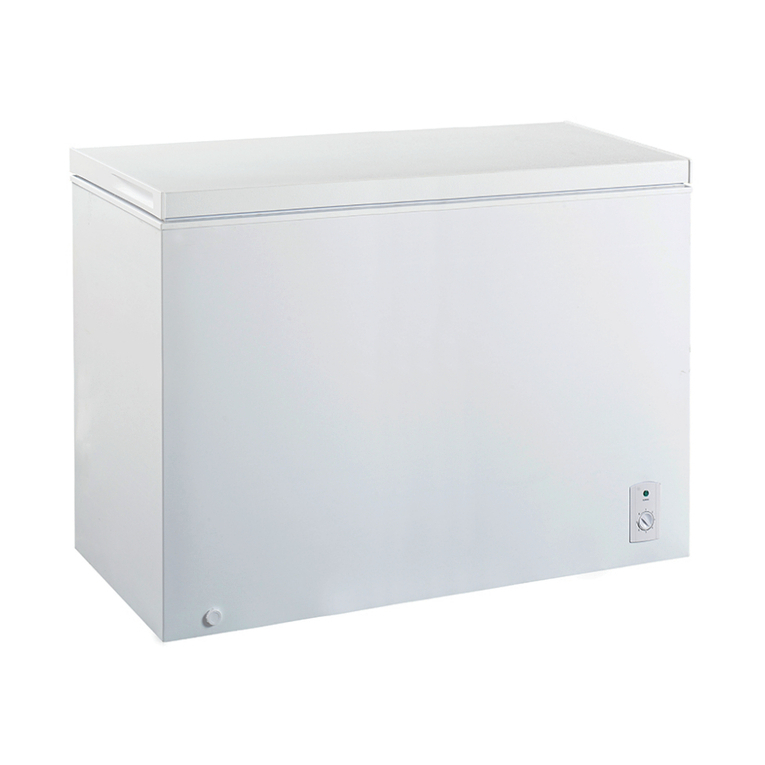
GERATEK
GERATEK Windsor GT3010W User manual

GERATEK
GERATEK Turku GT3000W Specification sheet
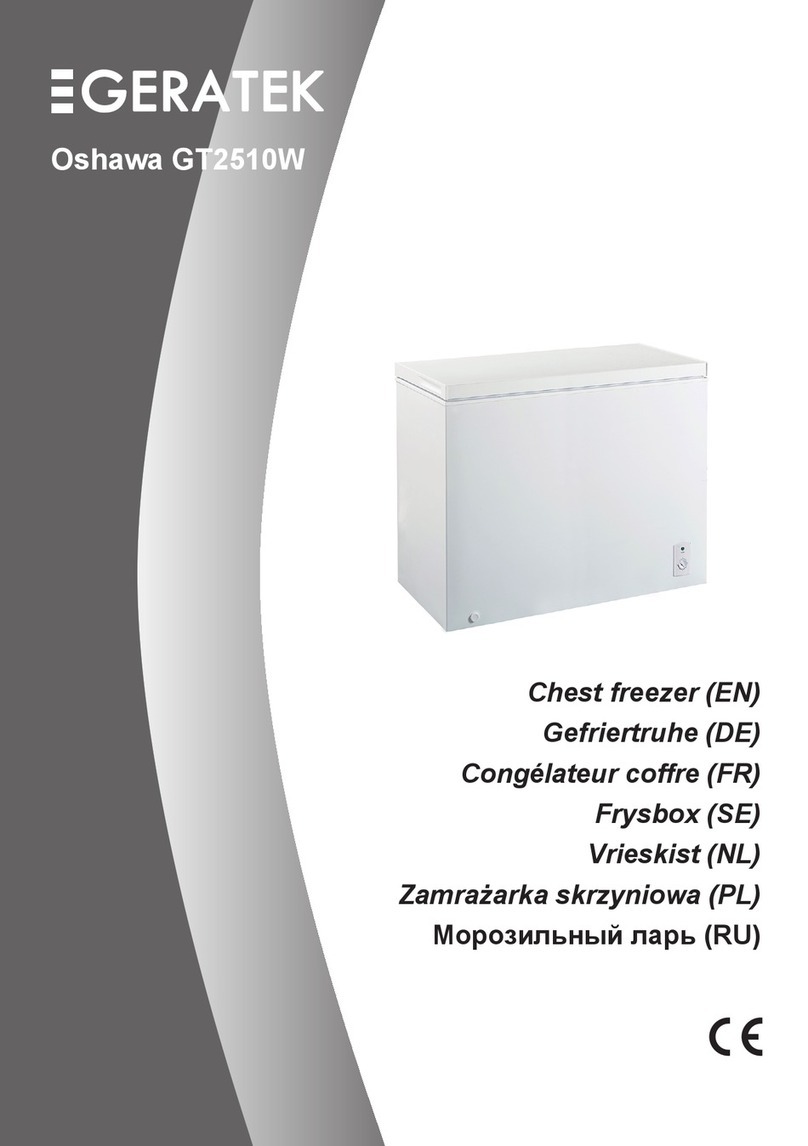
GERATEK
GERATEK Oshawa GT2510W User manual

GERATEK
GERATEK Victoria GT1200W User manual
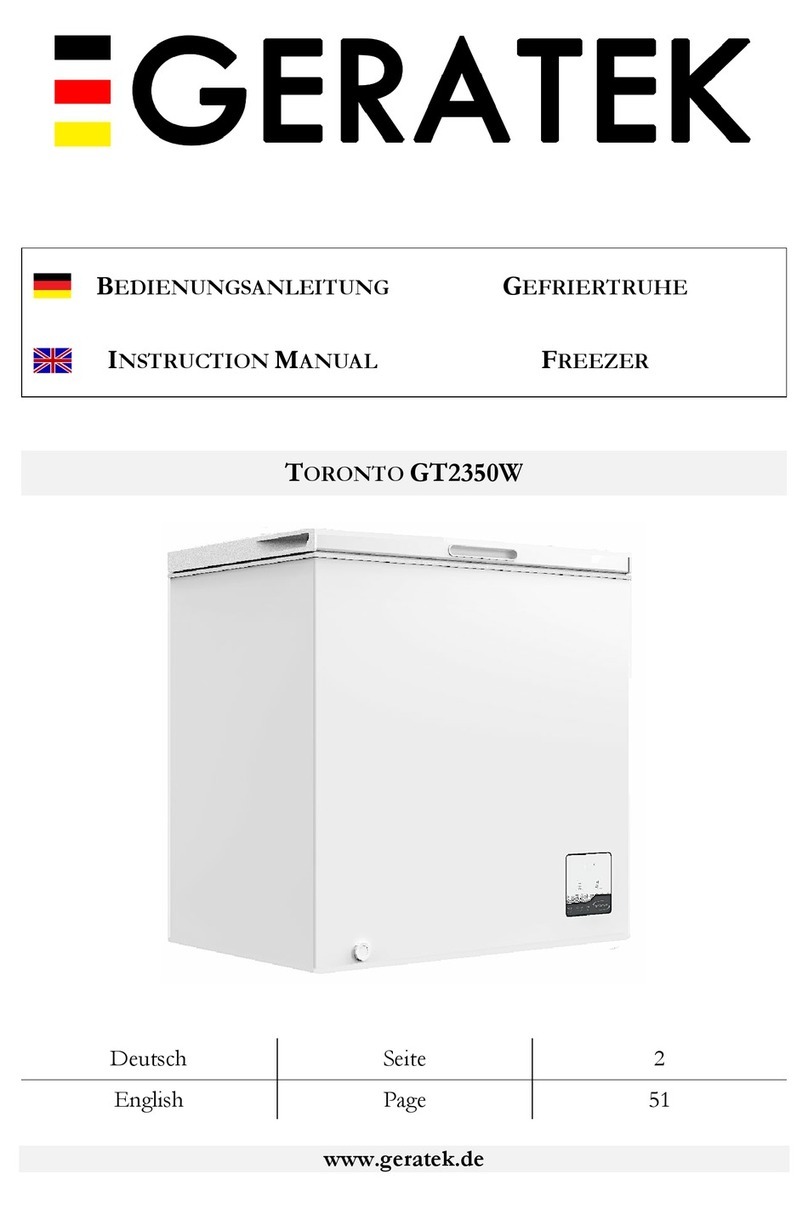
GERATEK
GERATEK TORONTO GT2350W User manual

GERATEK
GERATEK KELOWNA GT3300W User manual
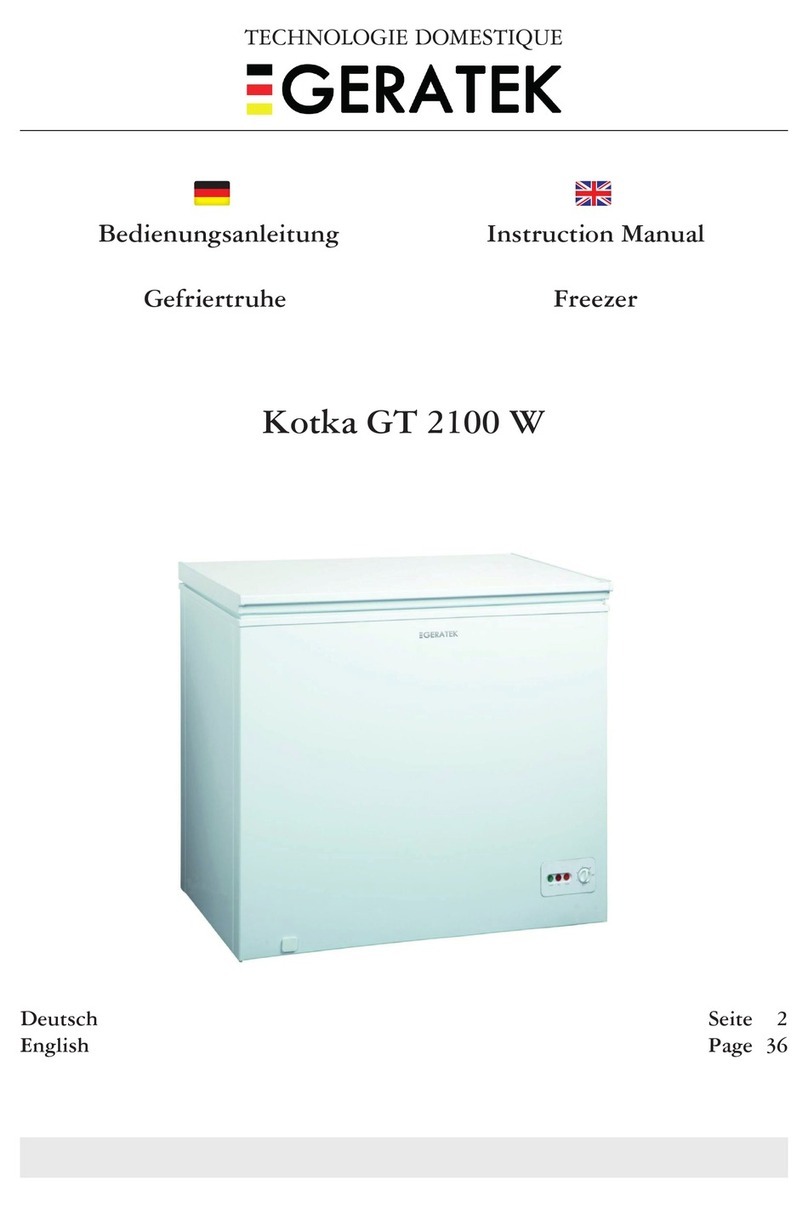
GERATEK
GERATEK Kotka GT 2100 W User manual




